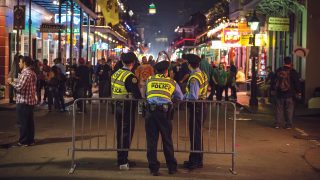
The year 2020 brought about numerous acts of civil disorder, demonstrations, protests, and riots. The results included toppled statues, defaced monuments, property damage, incidents of arson and injuries to innocent people. What is dismaying is how law enforcement responded to these acts of violence. Instead of responding with trained riot control teams (RCTs), law enforcement agencies responded with teams and leaders untrained in the use of different formations and tactics, who strayed from the tactics when the geography and the situation changed instead of adapting to those changes. This article will discuss and explain the difference between a protest, a demonstration, and a riot, and what law enforcement can do to prepare for civil disorder.
When people think of the terms “riot,” “demonstration,” “protest” and “civil disorder,” certain thoughts and images appear. When we listen to the news, we see deliberate or unintentional descriptions of incidents and the convolution of terms. In Minneapolis, an MSNBC reporter used the phrase “mostly a peaceful protest” to describe the events as buildings burned and rioters looted and ran amuck through the streets behind him. So, can we describe such events as “mostly a peaceful protest” or a riot?
The word riot is defined in 18 USC 2102, Chapter 102, and can generally be defined as a gathering of a group or a crowd of people that erupts into violence or has a credible threat of violence. The word was first recorded between 1175 and 1225 CE. Chapter 102 also defines the term civil disorder to mean “any public disturbance involving acts of violence by assemblages of three or more persons, which causes an immediate danger of or results in damage or injury to the property or person of any other individual.” So, the words riot and civil disorder have the same definition but are defined differently based on how they are used in a sentence. You can call several people rioters during a riot occurring at a time of civil disorder.
The word protest is defined as “an expression or declaration of objection, disapproval or dissent, often in opposition to something a person is powerless to prevent or avoid” and was first recorded during the 1300s. The word demonstrator was first used in 1611 and is defined as “a person who is part of an event in which people gather together in order to show that they support or oppose something or someone; a person who participates in a demonstration.” In colloquial terms, just as riot and civil disorder mean the same thing, so do demonstration and protest.
Many of the municipalities that experienced some form of civil disorder have liberal policies that restrict law enforcement in response, tactics and enforcement and legitimize civil disobedience and belligerent behavior. Liberal politicians and the media have demonized law enforcement with the stigma that since we do not live in a “police state,” possessing or purchasing equipment that appears to “militarize” law enforcement is a no-no. However, to respond to and quell any riot or civil disorder requires law enforcement to use equipment meant to disarm a crowd and protect and ensure the safety of the responding officers. Without a unified front from chiefs of police, sheriffs and police unions to educate and challenge policies implemented by elected officials clueless or apathetic about how we do our jobs, the events of Portland, Seattle and Minneapolis will become commonplace.
I have scoured resources, and two manuals stand out as the definitive manuals on SWAT and riot control tactics. It is possible there is reference material superior to these two publications, and if so, sharing those references is the prudent thing to do. The first manual is published by the National Tactical Officers Association (NTOA) and was last updated in 2018; you can download a PDF copy at ntoa.org/pdf/swatstandards.pdf. This manual describes and explains the ethical, legal, logistical and administrative components and characteristics of a SWAT team. The second manual is Army Field Manual FM-3-19.15, Civil Disturbance Operations (2005), and you can download a PDF file at irp.fas.org/doddir/army/fm3-19-15.pdf. This manual provides illustrations, descriptions and explanations of the formations and tactics used in various riot control situations.
Because the majority of law enforcement agencies are too small and/or lack the budgetary funding to possess their own SWAT/SRT team, memorandums of understanding (MOUs) between several agencies are signed. The signature agencies agree to provide the personnel to compose their local SWAT/SRT teams to serve their community. Law enforcement agencies must do the same thing to create properly trained, experienced and ready riot control teams (RCTs) to assemble at a designated place and time to quell unruly crowds and incidents of riots. By combining the elements and tactics of both response teams, each team’s functionality can be improved in its efficacy. Relying on the National Guard or other resources means getting untrained people, which can cause unnecessary injury.
Chiefs and sheriffs must be proactive in insisting to elected officials that our oath of office and our duty to the citizens we are sworn to protect prohibits law enforcement from doing nothing. Elected officials must be informed that the mindset “that’s why we have insurance” is a dangerous and idiotic position and that insurance companies, their policyholders and the citizens become victims several times over when rioters and looters are permitted to break the law.
Chiefs and sheriffs must respond to the “demilitarization” and “defund the police” rhetoric and provide well-researched, evidence-based, common-sense presentations describing the fodder and fallacy of such movements and the necessity for properly trained and equipped riot control law enforcement officers. These presentations should demonstrate that a “show of force” at the formation of large gatherings that threat assessments determined have a credible threat of violence often defuses the volatile nature of those gatherings, and although there may be some disturbances, violence, looting and destruction are avoided.
Originally, I was going to explain various riot control formations and how they can be deployed and used, but the material is too in-depth, involved and lengthy. I could not do justice to the complexities of riot control unless I were to actually teach the formations to designated riot control teams and we practiced hours, days, weeks and months until every member of the team was proficient and became subject-matter experts. As with the complexities of our jobs and the training, retraining, practice, mentorship and experience we need to become proficient as police officers, the same is necessary to become competent, proficient and experienced riot control team members. The best advice I can give is to obtain a copy of each manual I have listed, read each source, regard each source as a bible and practice, practice, practice until the fluidity of the commands and formations for riot control become second nature.
As seen in the November 2021 issue of American Police Beat magazine.
Don’t miss out on another issue today! Click below:





